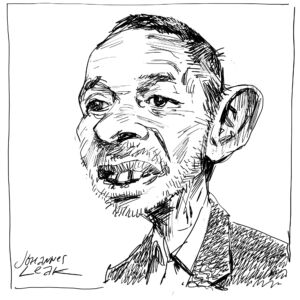No, it’s not ‘just like slavery’
So-called modern slavery is more fiction than fact.

Whenever someone declares, ‘it’s just like slavery’, it is useful to remind yourself that the only thing that is ‘just like slavery’ is slavery. Because of its highly charged association with human evil, the term slavery has been hijacked by numerous moral entrepreneurs intent on drawing attention to their own causes. I can’t recall a time over the past 100 years when analogies with slavery were so frequently drawn in public life.
The opportunistic use of the slavery analogy is not confined to any particular political side. At a recent anti-abortion rally, Ben Carson, the Republican presidential candidate, used the slavery analogy to stigmatise abortion. He said ending abortion would be the moral equivalent of the abolition of slavery. Animal-rights advocates embrace a similarly provocative tactic. Recently, music mogul Russell Simmons, alongside pressure group Mercy for Animals, denounced those running New York’s horse carriages as ‘people for slavery’.
One African-American pastor, E Dewey Smith, caused outrage when he accused his community of behaving like a ‘slavemaster’ in its attitude towards LGBT people. ‘We have done what the slavemaster done to us’, stated Smith. And a recent editorial in the Lexington Herald-Leader in Kentucky said ‘climate deniers’ were the spiritual heirs of slave owners and compared defenders of the coal industry to those who clung to slavery in America’s Old South.
It is truly remarkable that both hardline reactionaries and radical protesters have opted to express themselves through slavery analogies. As Kenyon Farrow, a critic of Occupy Wall Street’s slavery-obsessed rhetoric, recalled: ‘One of the first photos I saw from the Occupy Wall Street protests was of a white person carrying a flag that read “Debt=Slavery”.’ Farrow also noted that ‘white progressive media venues often compare corporate greed or exploitation to some form of modern-day slavery’. Not surprisingly, the likening of debt to slavery has caught on, with protesters in Greece and other parts of southern Europe embracing it.
The promiscuous use of the slavery analogy is no longer confined to the margins of Western society. It appears that most international institutions and many Western governments have sought to gain a measure of moral authority through appearing to take a stand against so-called modern slavery. The British prime minister, David Cameron, regularly uses his overseas visits to strengthen his claim to be a fearless fighter of the scourge of modern slavery. The British parliament has now enacted a Modern Slavery Act, which has led to the establishment of the new post of anti-slavery commissioner. One consequence of the Modern Slavery Act is that, from October onwards, approximately 12,000 of the largest companies in the UK will be required to make annual disclosures about what they are doing to ensure that slavery is eradicated in their supply chain
A crime by analogy
Anyone listening to politicians and campaigners holding forth about the growing scourge of modern slavery would draw the conclusion that a very insidious and evil crime against humanity is on the rise. Campaigners regularly contend that the scale of modern slavery beggars belief. Jimmy Carter, the former US president, accompanied the promotion of his book, A Call to Action: Women, Religion, Violence and Power, with the preposterous claim that not only was slavery a ‘serious problem in the US’, but that it was also ‘more prolific now than during the eighteenth and nineteenth century’. Carter’s fantasy history passed unchallenged, which is unsurprising given the all-party consensus on the prevalence of modern slavery.
Modern slavery has become an all-purpose portmanteau category into which every form of unpleasant and oppressive labour-related practice can be inserted. Cheap labour in a developing society, especially when it involves young people, is frequently classified as slavery. Such practices can and should be condemned for taking advantage of poor and powerless people. But harsh labour conditions do not constitute slavery.
The attribution of the experience of slavery to normal forms of exploitative labour conditions is one way of fiddling the modern-slavery figures. Another way of creating modern slavery is sheer speculation. The title of an article by Jeff Nesbit, a former White House communications director, says it all: ‘No one knows the numbers. That’s what’s so scary!’ Here the absence of facts about modern slavery constitute the very foundation for the scaremongering. The absence of facts frees advocates of the modern-slavery campaign to speculate at will. Just listen to Nesbit: ‘It could be more than at any time in human history. It might be less (though that’s doubtful). What is true is that there are millions who are trapped, with virtually no recourse.’
Almost imperceptibly, the statement ‘it could be more’ turns into the unassailable truth that there are ‘millions who are trapped’. Claims-makers rely on the ‘it is only the tip of the iceberg’ argument. Such arguments are based on the conviction that what matters is what you cannot see or know, rather than the visible facts. As Nesbit explains: ‘We don’t know the number of global victims; criminal enforcement is virtually non-existent; and hidden populations may be so vast that what we do know is just the tip of the iceberg.’ That’s another way of repeating the old religious adage, ‘Believe!’.
The exhortation to ‘believe the worst’ is occasionally supplemented by advocacy research. Last year, the UK government trailed the launching of its ‘modern-slavery strategy’ by claiming that it was based on the ‘first scientific estimate’ of modern slavery in the UK. According to the government, there were between 10,000 and 13,000 slaves in the UK last year. But professor Bernard Silverman, who came up with this figure, was less than categorical about the objectivity of his ‘statistical analysis’: ‘Modern slavery is very often deeply hidden and so it is a great challenge to assess its scale.’ A ‘hidden’ problem that cannot be seen and which is a ‘great challenge to assess’ is nevertheless captured by the ‘first scientific estimate’! Here, science is used metaphorically to lend meaning to a crusade, to provide campaigners with a vague estimate — what is usually known as a guestimate.
The government’s statistics were based on the quantification of intuition, guesswork and speculation. To his credit, Silverman warned that the ‘data collected is inevitably incomplete and, in addition, has to be very carefully handled because of its sensitivity’. Yet this set of ‘incomplete data’ now serves as the foundation for policymaking by a government which claims its policy is ‘based on evidence’. The insights of a competent astrologist, fortune-teller or soothsayer would be no less scientific than this official calculation.
It is regrettable that so many policymakers and politicians feel compelled to embrace a problem that they have invented. Some use the issue of modern slavery to gain a measure of moral credibility. Others genuinely perceive acts of injustice through the prism of the slavery analogy. No doubt campaigners against modern slavery are genuinely concerned by what they perceive as an evil. But it is an evil of their own imaginations, and their reaction does little to help the powerless and impoverished people living in other parts of the world. The anti-modern-slavery campaign doesn’t only trivialise the experience of real slavery; it also distracts attention from the genuine cases of evil that confront humanity today.
Modern slavery is a feelgood crime – one that provides an opportunity for some moral posturing. We are witnessing a proliferation of international initiatives and conferences on modern slavery. Next time you hear someone say ‘it’s just like slavery’, tell them to use arguments rather than seek refuge in specious, overused analogies.
Frank Furedi is a sociologist and commentator. His latest book, First World War: Still No End in Sight, is published by Bloomsbury. (Order this book from Amazon (UK).)
Picture: Shutterstock/Peerayot.
To enquire about republishing spiked’s content, a right to reply or to request a correction, please contact the managing editor, Viv Regan.









Comments
Want to join the conversation?
Only spiked supporters and patrons, who donate regularly to us, can comment on our articles.